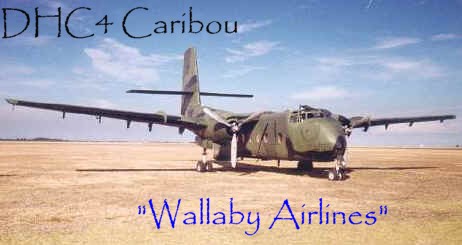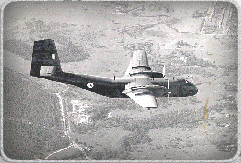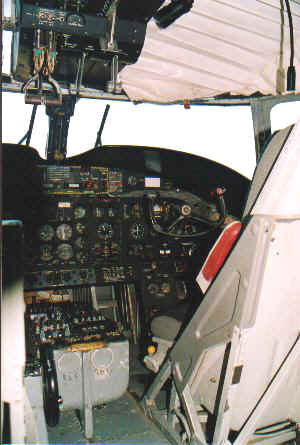 |
|
|||
|
|
||||
 |
| No aircraft has seen the
length of service in Australia of the Dakota, having notched up 52 years
as transports in the RAAF.
When the decision was made in the sixties for the elusive "Dakota replacement" it was not an easy choice; the aircraft which best measured up coming from the rugged lineage of the de Havilland Aircraft of Canada (DHC) stable. The RAAF was already familiar with the DHC Beaver and Otter, and the short takeoff and landing (STOL) field performance of the Caribou was ideal as a transport for army support work.
Three aircraft were then ferried by 38 Squadron crews 25,700km (16,000 miles) to Australia, via the Atlantic, Europe and Indian Ocean, arriving at Richmond on April 22. The initial 18 aircraft were serialled with scattered numbers between, A4-134 and A4-210.
The following November a further seven aircraft were ordered to replace this loss and the six deployed to Vietnam. These Caribou were delivered in 1966, with scrambled serials between A4-225 and A4-236. Australia's Caribou detachment in Vietnam began winding down in June 1971, and the last aircraft arrived back at Richmond on February 26 1972. Meanwhile since 1965, a flight from 35 Squadron had been operating from Port Moresby, PNG, providing transport support for the PNG Defence Force. Until their withdrawal in 1975, nearly 27,000 hours were flown by the crews of the three Caribou of the detachment. A final four Caribou were delivered over the 1968 - 1971 period, serialled between A4-264 and A4-299, and with these aircraft the RAAF was able to support survey operations in Indonesia in addition to various UN and Red Cross commitments. From March 1975 to November 1978 a white coloured 35 Sqn Caribou in United Nations markings operated with the UN Military Observer Group in India-Pakistan (UNMOGIP). Duties entailed resupply and remanning observation posts to monitor the ceasefire line in the North West Frontier. During the fighting in Timor in 1975, Caribou aircraft of 35 Squadron, in Red Cross markings, flew daily mercy missions from Darwin carrying supplies to refugees in East Timor. One of the Caribou's great virtues is the capability to operate from relatively crude dirt strips which cannot be used by other military transports. This light "footprint" has been lacking in any of the Caribou's competitors or successors. The aircraft has been used by the RAAF for flare dropping missions, medical evacuation, SAR and paratroop training exercises, but the main task is the airlift of troops, civilians, supplies, ammunition, mail and food. On July 1 1976, 35 Sqn relocated to RAAF Townsville from Richmond, and formed a composite unit with Iroquois helicopters in support of the Army in North Queensland. When the Iroquois later transferred to the Army, 35 and 38 Squadrons formed No 84 Wing of the Operational Support Group. Until 1988 two Caribou served at Butterworth with Transport Support Flight, and later 79 Squadron, supporting Mirage operations and the deployed Army infantry company, as well as duties for the embassies in the region. Detachments from 35 Squadron provide SAR and local transport requirements for Darwin and Pearce, as well as supporting Army units with training exercises. An ongoing requirement for 38 Sqn is the support of the Parachute Training School at HMAS Albatross at Nowra. On May 30 1991 the Minister of Defence announced the Caribou fleet would be reduced from 21 to 14 aircraft, and A4-164 was the first withdrawn from service in November 1992. With the move of 38 Sqn to Kimberley in December 1992, aircraft withdrawn from service will be stored at Amberley to provide a source of spares for the fleet. The Caribou will be soldiering on to the end of the century, based in Queensland and maintaining detachments at Darwin and Pearce. |
De Havilland Canada DHC-4A Caribou
The RAAF took delivery of its first Caribou at DHC's Downsview plant in February 1964, from which it and its companions arrived by a series of ferry flights to equip 38 Sqn., Richmond, New South Wales, during the last half of the year. The squadron moved to Amberley, Queensland in 1992. Six Caribou served with RFTV (RAAF Transport Flight Vietnam) at Vung Tau, the first RAAF unit serving in Vietnam, and the last to withdraw. The RFTV became 35 Sqn., also known as 'Wallaby Airlines', remaining in Vietnam until February 1972. The RAAF's Caribous have performed a variety of roles, flying mercy flights to refugees, supplying UN peace-keeping forces, and assisting in times of civil disasters such as floods. Although long serving and due for replacement with parts becoming scarce, there is some difficulty in finding an aircraft with equivalent qualities to the Caribou. |
 The
Caribou is a twin engined, light tactical transport with rear opening
ramp doors to allow rapid loading and unloading The prototype first flew
on July 30 1958. Eighteen aircraft were ordered for the RAAF in May 1963
and the first aircraft, serialled A4-134 (constructor's number 134), was
handed over at the DHC plant at Downsview, near Toronto, on February 25
1964.
The
Caribou is a twin engined, light tactical transport with rear opening
ramp doors to allow rapid loading and unloading The prototype first flew
on July 30 1958. Eighteen aircraft were ordered for the RAAF in May 1963
and the first aircraft, serialled A4-134 (constructor's number 134), was
handed over at the DHC plant at Downsview, near Toronto, on February 25
1964.

